|
Kamasutra
Art Gallery - 2
|
|
|

|
A close and passionate embrace, says Vatsyayana,
can turn without warning into lovemaking, and these lovers are twined in a
knot reminiscent of what Kama Sutra calls the Sesame & Rice
embrace. The attendant holding a torch looks discreetly away.
Making love in front of an audience of servants does not seem to bother
these haughty Rajput nobles and their ladies. This miniature, with
its curious earthly palette, was one of a set probably painted at the
minor court of Sirohi. Sirohi, eighteenth century. |
| Between the thirteenth century AD, when the
sculptors of Konarak covered the Sun Temple in dozens of rapturously
kissing couples, and 1978, when Zeenath Aman horrified Indian film critics
by passionately kissing Shashi Kapoor in Satyam Shivam Sundaram, the
kiss seems to have disappeared from Indian public life. The man in
this painting may be kissing his lover as they make love, moving into the Paravrittaka
posture and if so he is probably using the gentle kiss of Mridu.
Mewar, early eighteenth century? |
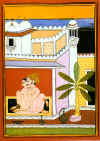 |
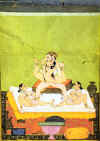 |
An extravagant way to steal what Vatsyayana
calls a Lifted kiss. The painting bears an extraordinary resemblance
to a sculpted group on the Vishwanath temple at Khajuraho, in which
lovers' long leaf-shaped eyes seem to be closed in anticipation of the
meeting of their lips. Perhaps the painter had travelled to
Khajuraho and seen the temples. Mewar, late eighteenth century. |
| In this luminous, very stylized painting, the
royal lovers are shown in the posture of Indranika named for
indrani, wife of god Indra. On the man's cheek, there is a deep,
angry mark, perhaps a Half Moon made by her nails, or the bruise of the
Swollen lovebite, which is often made on the left cheek. The
diaphanous jama of the prince is particularly finely handled. Jaipur,
late eighteenth century. |
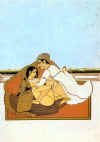 |
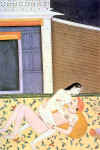 |
In ancient India it was considered so abnormal
for a man to adopt a submissive role that the purushayita, or
female-superior postures, discussed by Vatsyayana in the chapter on role
reversal, were thought rather daring and consequently were rare delights.
The creases that run from either side of her nose are deeply drawn, a
characteristic that sometimes appears, although more delicately, in Guler
painting. Pahari, Sikh School, nineteenth century. |
| A prince or nobleman of Kotah makes love with
his wife in the Manmathpriya posture. If she were to lift
her feet to his shoulders the posture would change to Jrimbhitaka, from
which a further sequence could be developed. The lady's loose hair,
which indicates passion is finely painted. Sometimes single-haired
brushes were used to put in these minute details. Note the well stocked
box of paans beside the bed. Kotah, c. 1760 |
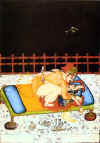 |

